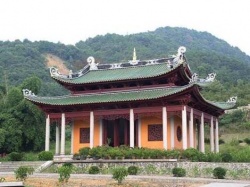Nanhua Temple - Chinese Buddhist Monastery
Nanhua Temple (南华寺) is a Buddhist Monastery of the Chan School - one of Five Great Schools of Buddhism, where the 6th Patriarch of the Chan School of Buddhism - the Great Master Hui Neng - once dwelled and spoke The Dharma. It is located 25 km southeast of Shaoguan, China in the town of Caoxi (漕溪), within Qujiang District. The location is in the northern part of Guangdong Province, within a few kilometers from Bei River, formerly an important trade route from Central China to Guangzhou.
The temple was founded during the Time of the North-South Dynasties in 502 AD by an Indian Monk named Zhiyao Sanzang (智乐三藏) who originally named the site Baolin Temple (宝林寺). It received its present Name in 968 during the reign of the Song Dynasty Emperor Taizong. The site was later renovated in 1934 under the Leadership of Hsu Yun.
The temple covers an area of more than 42.5 hectares (105 acres). It consists of a set of magnificent Buddhist buildings, including the Hall of Heavenly Kings, the Grand Hall, Sutra Depository, Sixth Ancestor Hall, Lingzhao Pagoda and 690 Buddhist Statues.
The majestic Hall of Heavenly Kings was originally built in 1474 during the Ming Dynasty (1368-1644) and rebuilt during the Qing Dynasty (1644-1911). The statue of Maitreya Bodhisattva is enshrined in the hall and the mighty Statues of The Four Heavenly Kings holding religious objects stand on both sides of the statue of Maitreya. Behind the hall is a three-storey Bell tower which was constructed in 1301 during the Yuan Dynasty (1271-1368). On top of the Bell tower there hangs a brass Bell from the Southern Song Dynasty (1127-1279). The massive Bell is 2.75 meters (9 ft) high with a diameter of 1.8 meters (5.9 ft).
The Grand Hall, constructed during the Yuan Dynasty (1271-1368), stands in the center of the temple. Covered by glazed tiles, it houses the Buddha statues of Sakyamuni, Medicine Master, and Amitabha, which are situated in the sacrarium of the hall. These gilded figures are all over 8.3 meters (27 ft) high. Within the Grand Hall there are about 500 fine clay sculptures of Buddhist Arhats.
The temple holds many precious cultural Relics; the most precious being the statue of Hui Neng, which is worshiped in the Sixth Ancestor Hall. There are 360 Buddhist Arhats figures which are the only Chinese wooden carvings preserved from the Northern Song Dynasty (960-1127)and a rare cassock trimmed with the dainty embroidery of over 1,000 Buddhist figures.
The first account of Nanhua Temple for the European audience was most likely provided by Matteo Ricci, who visited it in August or September 1589, when relocating from Zhaoqing to Shaoguan. The Jesuit was impressed by the temple, "magnificent in grandeur", and its fountain, "graciously designed and wonderfully built", as well as by the beautiful surroundings, but viewed the "idol-worshipping emissaries of the Satan" (i.e., Buddhist clergy) with disdain. He saw the Relics of the Sixth Patriarch (Lusu, i.e. 六祖, Liu Zu, in RIcci's account) as well. The local authorities had suggested to the missionaries (Ricci and his younger colleague, Antonio Almeida) that they can find a place to live on the temple compound, but they strongly preferred to live in the city instead, closer to the region's ruling elites.
